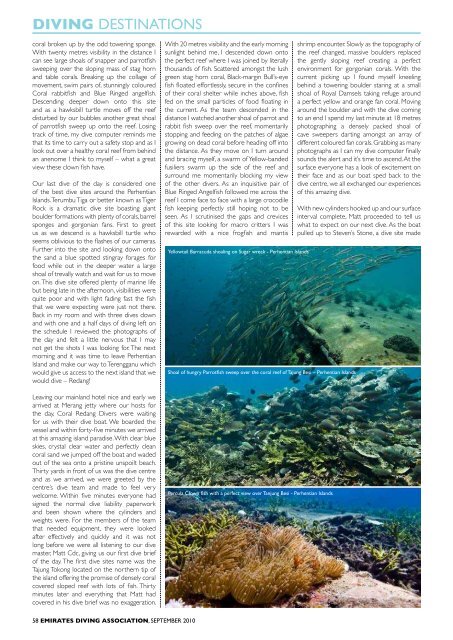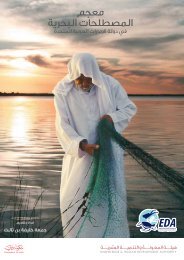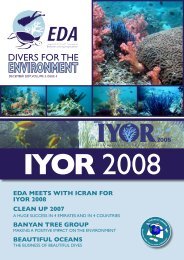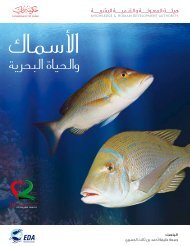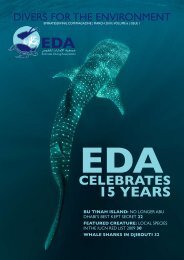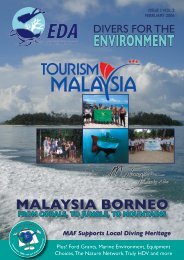NEWS - Emirates Diving Association
NEWS - Emirates Diving Association
NEWS - Emirates Diving Association
You also want an ePaper? Increase the reach of your titles
YUMPU automatically turns print PDFs into web optimized ePapers that Google loves.
DIVING DESTINATIONS<br />
DIVING DESTINATIONS<br />
coral broken up by the odd towering sponge.<br />
With twenty metres visibility in the distance I<br />
can see large shoals of snapper and parrotfish<br />
sweeping over the sloping mass of stag horn<br />
and table corals. Breaking up the collage of<br />
movement, swim pairs of, stunningly coloured<br />
Coral rabbitfish and Blue Ringed angelfish.<br />
Descending deeper down onto this site<br />
and as a hawksbill turtle moves off the reef<br />
disturbed by our bubbles another great shoal<br />
of parrotfish sweep up onto the reef. Losing<br />
track of time, my dive computer reminds me<br />
that its time to carry out a safety stop and as I<br />
look out over a healthy coral reef from behind<br />
an anenome I think to myself – what a great<br />
view these clown fish have.<br />
Our last dive of the day is considered one<br />
of the best dive sites around the Perhentian<br />
Islands. Terumbu Tiga or better known as Tiger<br />
Rock is a dramatic dive site boasting giant<br />
boulder formations with plenty of corals, barrel<br />
sponges and gorgonian fans. First to greet<br />
us as we descend is a hawksbill turtle who<br />
seems oblivious to the flashes of our cameras.<br />
Further into the site and looking down onto<br />
the sand a blue spotted stingray forages for<br />
food while out in the deeper water a large<br />
shoal of trevally watch and wait for us to move<br />
on. This dive site offered plenty of marine life<br />
but being late in the afternoon, visibilities were<br />
quite poor and with light fading fast the fish<br />
that we were expecting were just not there.<br />
Back in my room and with three dives down<br />
and with one and a half days of diving left on<br />
the schedule I reviewed the photographs of<br />
the day and felt a little nervous that I may<br />
not get the shots I was looking for. The next<br />
morning and it was time to leave Perhentian<br />
Island and make our way to Terengganu which<br />
would give us access to the next island that we<br />
would dive – Redang!<br />
Leaving our mainland hotel nice and early we<br />
arrived at Merang jetty where our hosts for<br />
the day, Coral Redang Divers were waiting<br />
for us with their dive boat. We boarded the<br />
vessel and within forty-five minutes we arrived<br />
at this amazing island paradise. With clear blue<br />
skies, crystal clear water and perfectly clean<br />
coral sand we jumped off the boat and waded<br />
out of the sea onto a pristine unspoilt beach.<br />
Thirty yards in front of us was the dive centre<br />
and as we arrived, we were greeted by the<br />
centre’s dive team and made to feel very<br />
welcome. Within five minutes everyone had<br />
signed the normal dive liability paperwork<br />
and been shown where the cylinders and<br />
weights were. For the members of the team<br />
that needed equipment, they were looked<br />
after effectively and quickly and it was not<br />
long before we were all listening to our dive<br />
master, Matt Cdc, giving us our first dive brief<br />
of the day. The first dive sites name was the<br />
Tajung Tokong located on the northern tip of<br />
the island offering the promise of densely coral<br />
covered sloped reef with lots of fish. Thirty<br />
minutes later and everything that Matt had<br />
covered in his dive brief was no exaggeration.<br />
With 20 metres visibility and the early morning<br />
sunlight behind me, I descended down onto<br />
the perfect reef where I was joined by literally<br />
thousands of fish. Scattered amongst the lush<br />
green stag horn coral, Black-margin Bull’s-eye<br />
fish floated effortlessly, secure in the confines<br />
of their coral shelter while inches above, fish<br />
fed on the small particles of food floating in<br />
the current. As the team descended in the<br />
distance I watched another shoal of parrot and<br />
rabbit fish sweep over the reef, momentarily<br />
stopping and feeding on the patches of algae<br />
growing on dead coral before heading off into<br />
the distance. As they move on I turn around<br />
and bracing myself, a swarm of Yellow-banded<br />
fusiliers swarm up the side of the reef and<br />
surround me momentarily blocking my view<br />
of the other divers. As an inquisitive pair of<br />
Blue Ringed Angelfish followed me across the<br />
reef I come face to face with a large crocodile<br />
fish keeping perfectly still hoping not to be<br />
seen. As I scrutinised the gaps and crevices<br />
of this site looking for macro critters I was<br />
rewarded with a nice frogfish and mantis<br />
Yellowtail Barracuda shoaling on Sugar wreck - Perhentian Islands<br />
Shoal of hungry Parrotfish sweep over the coral reef of Tajung Besi – Perhentian Islands<br />
Percula Clown fish with a perfect view over Tanjung Besi - Perhentian Islands<br />
shrimp encounter. Slowly as the topography of<br />
the reef changed, massive boulders replaced<br />
the gently sloping reef creating a perfect<br />
environment for gorgonian corals. With the<br />
current picking up I found myself kneeling<br />
behind a towering boulder staring at a small<br />
shoal of Royal Damsels taking refuge around<br />
a perfect yellow and orange fan coral. Moving<br />
around the boulder and with the dive coming<br />
to an end I spend my last minute at 18 metres<br />
photographing a densely packed shoal of<br />
cave sweepers darting amongst an array of<br />
different coloured fan corals. Grabbing as many<br />
photographs as I can my dive computer finally<br />
sounds the alert and it’s time to ascend. At the<br />
surface everyone has a look of excitement on<br />
their face and as our boat sped back to the<br />
dive centre, we all exchanged our experiences<br />
of this amazing dive.<br />
With new cylinders hooked up and our surface<br />
interval complete, Matt proceeded to tell us<br />
what to expect on our next dive. As the boat<br />
pulled up to Steven’s Stone, a dive site made<br />
up out of four small reefs surrounded by sand,<br />
Matt jumped in, did a quick current check and<br />
signalled that all was fine. As we all entered the<br />
water and descended down onto the sandy<br />
bottom I could see that over the last ninety<br />
minutes visibilities had deteriorated slightly<br />
turning the water slightly milky. Although this<br />
was quite a small dive site, Matt’s decision to<br />
bring us to this reef was because on each of<br />
the small coral covered pinnacles were many<br />
different types of fish all competing for space.<br />
On one of these special pinnacles, busy Percula<br />
clown fish worked hard to protect their host<br />
while all around, a shoal of Ring-tail Cardinal<br />
fish competed for shelter from the relatively<br />
strong current. On another of the pinnacles, a<br />
pair of Sebae clown fish looked slightly more<br />
relaxed as they rest on their giant large carpet<br />
anenome observing a shoal of Moluccen<br />
Snapper. Scattered around on the sand lay<br />
blue spotted stingrays while around the base<br />
of the reefs, moray eels looked out of their<br />
crevices. Back on the boat and the team again<br />
congratulate Matt on his choice of dive site.<br />
A camouflaged Crocodile fish on Tajung Tokong – Redang Island<br />
Motivated by the appreciation of the EDA<br />
team, Matt announces that for our final dive<br />
of the day, he is going to introduce us to the<br />
stingrays of Redang on Paku Kecil.<br />
Feeling slightly tired I lifted my BCD with new<br />
cylinder up onto the boat and boarded, ready<br />
for this last dive. Dropping down onto this site<br />
was more spectacular than the other dives<br />
of the day. Slowly descending down onto the<br />
reef at eight metres and it is difficult to see<br />
the other members of the team as there are<br />
thousands of Green Chromis feeding in the<br />
current. Moving away from the reef and leaving<br />
the massive shoal of fish behind I join the team<br />
and we slowly set off in search of the stingrays<br />
of Redang. Looking onto the reef I see a large<br />
shoal of mono’s sheltering alongside batfish<br />
and squirrelfish in the shade of a giant boulder<br />
and as I approach to photograph them they<br />
disperse and disappear amongst the reef.<br />
Continuously keeping an eye on the sand<br />
for the rays I search for interesting things to<br />
photograph and as I lead the group I come face<br />
Moluccen Snapper shoal seeking cover while a pair of Sebae Clown fish rest with plenty of space on a giant carpet<br />
anenome – Steven’s Stone, Redang Island<br />
Confidently gauranteed, a Jenkins Whip ray on Paku Kecil – Redang Island<br />
to face with a large hawksbill turtle grazing on<br />
a patch of soft coral. With the group still with<br />
the turtle I head on and it is not long before I<br />
come face to face with two very large Jenkins<br />
Whip rays. As I approach, my bubbles disrupts<br />
one of them making it swim aggressively<br />
around the area before settling down again.<br />
Thinking better of it, I choose to approach the<br />
more settled of the two rays and amazingly as<br />
I photograph it the curious ray nudges slowly<br />
towards me until the tip of it’s nose touched<br />
the dome port of my camera. Face to face with<br />
this marvelous gentle creature I think of Matt’s<br />
confident promise of a special encounter<br />
and as I think about the days diving I wonder<br />
whether my camera holds the evidence I need<br />
to support my article.<br />
Back at the dive centre and with my equipment<br />
all packed away, I thank Matt and the rest of<br />
the Coral Redang Diver team and mention<br />
that I would love to return and spend more<br />
time diving their world class dive sites. As<br />
the boat returned to Terengganu I thought<br />
how the Coral Redang Divers team had<br />
done everything they could to provide an<br />
amazing diving experience. The whole team<br />
were friendly, all spoke excellent English, the<br />
equipment was all well maintained and most<br />
importantly for me, they had plenty of 15 litre<br />
cylinders.<br />
Three day’s later and sitting in Kuala Lumpur<br />
airport, getting ready to return to Dubai I<br />
take another glance over the photographs<br />
taken during the seven dives (three hundred<br />
and fifteen minutes of bottom time) and I<br />
am fairly satisfied with the results. I made the<br />
right decision to stick with shooting with a<br />
mid-range lens and with favourable visibilities<br />
my nikkor 17-55 DX lens had been versatile<br />
enough to capture all of the images in this<br />
article. In reflection, with the odds so heavily<br />
stacked against me, diving in Malaysia may<br />
have been a whirlwind experience, but every<br />
dive provided me with two or three great<br />
publishable photographs and memories that I<br />
will never forget.<br />
Will I return to do more diving in Malaysia?<br />
Most definitely – in my opinion Redang Island<br />
is a stunning place to go on vacation offering<br />
laid back diving on healthy coral reefs with a<br />
lot of stunning marine life.<br />
I would like to say a big thank you to<br />
Mr “A” of Malaysian airlines – without<br />
his amazing customer service and<br />
support I would never have been able<br />
to dive in Malaysia. A big thank you to<br />
all of the team at Malaysian Tourism<br />
both in Dubai and Malaysia for making<br />
my stay a special one. Finally, a very<br />
big thank you to Matt Cdc at Coral<br />
Redang Divers for recognising our<br />
needs and giving me one of the best<br />
diving experiences ever.<br />
58 EMIRATES DIVING ASSOCIATION, SEPTEMBER 2010 SEPTEMBER 2010, EMIRATES DIVING ASSOCIATION 59


